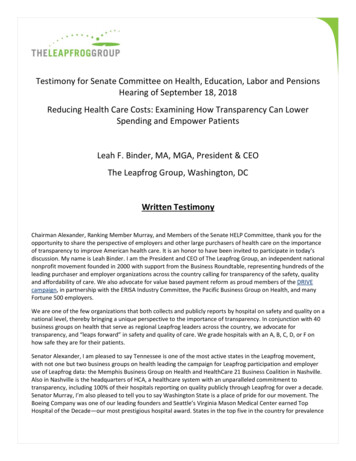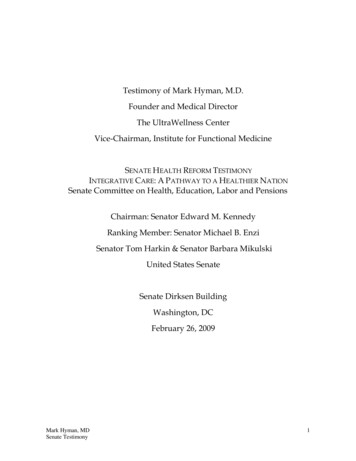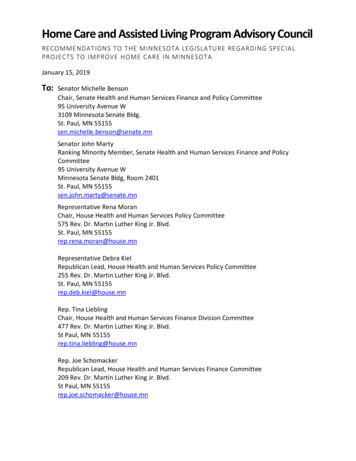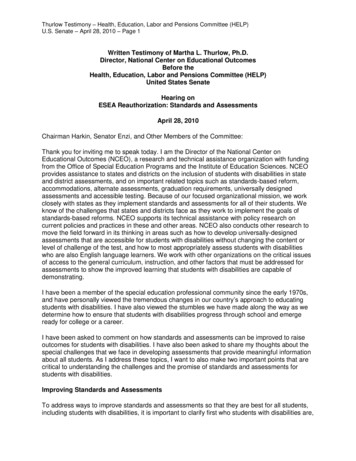
Transcription
Testimony for Senate Committee on Health, Education, Labor and PensionsHearing of September 18, 2018Reducing Health Care Costs: Examining How Transparency Can LowerSpending and Empower PatientsLeah F. Binder, MA, MGA, President & CEOThe Leapfrog Group, Washington, DCWritten TestimonyChairman Alexander, Ranking Member Murray, and Members of the Senate HELP Committee, thank you for theopportunity to share the perspective of employers and other large purchasers of health care on the importanceof transparency to improve American health care. It is an honor to have been invited to participate in today’sdiscussion. My name is Leah Binder. I am the President and CEO of The Leapfrog Group, an independent nationalnonprofit movement founded in 2000 with support from the Business Roundtable, representing hundreds of theleading purchaser and employer organizations across the country calling for transparency of the safety, qualityand affordability of care. We also advocate for value based payment reform as proud members of the DRIVEcampaign, in partnership with the ERISA Industry Committee, the Pacific Business Group on Health, and manyFortune 500 employers.We are one of the few organizations that both collects and publicly reports by hospital on safety and quality on anational level, thereby bringing a unique perspective to the importance of transparency. In conjunction with 40business groups on health that serve as regional Leapfrog leaders across the country, we advocate fortransparency, and “leaps forward” in safety and quality of care. We grade hospitals with an A, B, C, D, or F onhow safe they are for their patients.Senator Alexander, I am pleased to say Tennessee is one of the most active states in the Leapfrog movement,with not one but two business groups on health leading the campaign for Leapfrog participation and employeruse of Leapfrog data: the Memphis Business Group on Health and HealthCare 21 Business Coalition in Nashville.Also in Nashville is the headquarters of HCA, a healthcare system with an unparalleled commitment totransparency, including 100% of their hospitals reporting on quality publicly through Leapfrog for over a decade.Senator Murray, I’m also pleased to tell you to say Washington State is a place of pride for our movement. TheBoeing Company was one of our leading founders and Seattle’s Virginia Mason Medical Center earned TopHospital of the Decade—our most prestigious hospital award. States in the top five in the country for prevalence
Leah Binder, MA, MGA, The Leapfrog GroupTestimony to the Senate HELP Committee, September 18, 2018of “A” hospitals in every single update of our Safety Grade are Maine and Massachusetts. And just this month,two new business groups joined as Leapfrog leaders in each of their states, one in Louisiana and one in Alabama.We have history and relationships in states represented by every member of this committee.In this written testimony, I will describe Leapfrog’s main programs to improve transparency in health care, offerfrom our experience how transparency drives improvement and cost reduction, and summarize whytransparency has emerged as an urgent issue for consumers as well as employers and other purchasers. I willoffer our perspective on the defining elements of effective transparency, and three general policy principles andrecommendations for Committee consideration.Leapfrog’s Programs to Improve TransparencyLeapfrog is the gold standard in health care transparency in the United States. We collect data on hospitalquality and safety through the annual Leapfrog Hospital Survey, using evidence-based questions reviewed andsupported by peer-reviewed literature and review by top experts. Leapfrog Regional leaders, typically businessgroups on health, ask hospitals to voluntarily report the information. Leapfrog makes it freely available to thepublic.Almost 2,000 hospitals representing two-thirds of the nation’s hospital beds reported last year. Through theSurvey, employers and other purchasers as well as the public at large can monitor important issues of qualityand safety that are not publicly available by hospital from any other source. For instance, we report oncaesarean-delivery rates, medication safety, and pediatric patient satisfaction. That data is used by all nationalhealth plans, hundreds of purchasers, and many publishers of performance data. In 2019, we will launch aSurvey on quality and safety of hospital outpatient surgery and Ambulatory Surgery Centers.As mentioned above, Leapfrog publishes the Leapfrog Hospital Safety Grade, an A, B, C, D, or F assigned to over2,600 general hospitals in the United States twice a year. This is assigned to hospitals whether they voluntarilycomplete our Survey or not. The Hospital Safety Grade rates hospitals on their success preventing errors,accidents, and infections, and provides consumers information to begin their research when selecting a hospital.We calculate the Grade from 27 measures of safety derived from the Centers for Medicare & Medicaid Services(CMS) data and other sources including our own Survey if the hospital reports. We update the research and thegrades every six months.We find significant variation among hospitals on the prevalence of safety hazards, and that is costly in lives anddollars. In one analysis of our Hospital Safety Grades, researchers from Johns Hopkins Medicine estimated that33,000 lives would be saved annually if every hospital were as safe as “A” graded hospitals. The researchersfound that purchasers spent an average of 8,000 more for every inpatient visit as a result of patient safetyproblems. To help purchasers estimate lives and dollars at risk for their own employees, we provide a freecalculator which you may find enlightening for estimating dollars and lives lost among your constituents.Transparency Drives Improvement and Lowers CostsA stakeholder consensus report by the Lucian Leape Institute of the National Patient Safety Foundationconcluded “if transparency were a drug, it would be a blockbuster.” The report outlined how transparency jump-2 P a g e
Leah Binder, MA, MGA, The Leapfrog GroupTestimony to the Senate HELP Committee, September 18, 2018starts improvement from within health systems—when clinicians communicate candidly to each other—andoutside health systems, when information is shared with the public.One example the report cited came from Leapfrog, a case where transparency about maternity data drovedramatic improvement nationally. Specifically, after Leapfrog began publicly reporting hospital rates of earlyelective deliveries—deliveries scheduled early without a medical reason—rates began plummeting. Until thedata was transparent, progress lagged--despite efforts by some of the most influential organizations in thecountry, like the American College of Obstetricians and Gynecologists (ACOG) and the March of Dimes.Reporting rates by hospital galvanized the efforts of those organizations, hospitals, and others, so that thenational average went from 17% in 2010 to lower than 3% today, saving countless babies and mothers fromharm.We also see the power of transparency to drive improvement in patient safety. The measures that have beenprominently reported by CMS, Leapfrog, and others, such as central line infections, have shown dramaticimprovement nationally. Measures that have not been reported publicly or less prominently reported show lessimprovement. Extensive peer-reviewed literature suggests that the cost of complications and errors is highlysignificant; one study saw as much as 39,000 per infection for private purchasers. We conclude that drivingimprovement through transparency generates significant cost-efficiency as well as better care.Consumers and Payors Want TransparencyAt Leapfrog we see rapid growth in consumer interest in our ratings and ratings from other organizations. Whenwe update our ratings every six months, at least 3,000 news outlets across the country cover them, andhundreds of local radio stations broadcast news items or interviews about the new hospital ratings. The breadthof coverage increases with every update. And perhaps as significantly, hospitals pay close attention to howconsumers perceive their performance. Many hospitals tell us senior executive compensation is tied in part tothe Hospital Safety Grade, or clinicians are waging a major campaign to improve infection rates or readmissionsbecause a quality rating or ranking made the local newspaper. Most patient safety advocates find this highlygratifying, because traditionally there appeared to be few if any consequences for hospital leaders that did notput a priority on patient safety and quality. Transparency changes that.Part of the interest in health care ratings comes from the growth of ratings throughout American culture, nowubiquitous in all industries and driven by a digital economy. But that’s not the whole story, because health caredoesn’t typically stay on trend with the rest of the economy. Few doctors use email to reach patients, much lesssocial media, for instance, and fax machines have disappeared almost everywhere except doctor’s offices andhospitals. The growth in health care ratings comes in large part from the advent of high deductible health plans(HDHPs), coupled with tax-protected Health Savings Accounts or other arrangements to cover the deductible.Such plans were first authorized in 2003, with passage of the Deficit Reduction Act during the administration ofPresident George W. Bush. Subsequently high-deductible plans accelerated in adoption during the ObamaAdministration, authorized as part of state exchanges in the Affordable Care Act.3 P a g e
Leah Binder, MA, MGA, The Leapfrog GroupTestimony to the Senate HELP Committee, September 18, 2018Employers embraced HDHPs, in part as a way to put the brakes on their health costs and avoid the so-called“Cadillac Tax” in the Affordable Care Act. With the threat of the Cadillac Tax, it is no longer a competitivedisadvantage for a company to offer an HDHP. In 2004, a handful of Americans had a high deductible plan, whiletoday one in three workers are covered by one. This is a very significant shift, impacting our health care systemand indeed our entire economy.HDHPs are different from more traditional health plans, like PPOs or HMOs, where consumers pay one fixedcopay for each physician visit or prescription even if their plan has a deductible. With HDHPs consumers pay thewhole bill from the doctor or the hospital, and they shoulder the full cost of each prescription, until they spendpast the deductible. But deductibles are so high most people never reach it in a given year, so they are payingevery dime of their care all the time. This prompts them to think differently about their role in selecting thedoctor, approving a service, or taking a drug. They ask new questions: do I really need this 2,000 test? Is there adrug option cheaper than this prescription costing 500?This kind of consumer engagement creates a market and markets fuel competition, which can reduce costs.Indeed, a number of studies as well as actuarial reports cite HDHPs as a factor when national health spendinggrowth slows. The idea that spending growth in health care could ever slow suggests something dramatic aboutthe infrastructure of our health care system, which has stubbornly resisted cost control over decades. Employersreport savings of varying significance when they shift to HDHPs, and not one ever found that HDHPs raised theirhealth spending. That alone is a breakthrough for employers who have longed for some relief from theseemingly endless escalation in health costs.There are many debates about the merits of HDHPs and whether people get adequate care when covered byone. But HDHPs are a reality and policymakers and business leaders alike should work together to improve theireffectiveness. The challenge for all of us is to shape HDHPs in a way that works best for the health and economicwell-being of Americans. Employers have worked to accomplish that by subsidizing or in some cases fullyfunding Health Savings Accounts, offering second-opinion services and help navigating the system, and providingdirect support like telemedicine and onsite clinics.But employers always aim to preserve the fundamental principle behind HDHPs: that individuals should haveincentives to “shop” for health care services, which over the long run will be key to improving quality and costs.For that reason, we must ensure that people covered by HDHPs, as well as all Americans, can access informationthey need to make decisions. Though we have made progress on transparency--and Leapfrog was founded tohelp push that progress along--still today consumers have far too little information on quality and price to maketruly informed decisions. That makes living with an HDHP much more difficult, and limits the effectiveness ofconsumer behavior and opinion to drive positive change. It is hard for markets to gravitate toward the best careat the best price when information is inadequate.Effective Transparency: Two Defining Elements4 P a g e
Leah Binder, MA, MGA, The Leapfrog GroupTestimony to the Senate HELP Committee, September 18, 2018Before turning to Leapfrog’s recommendations on policy principles for improving transparency, it is important tospecify what Leapfrog means by transparency. In health care, too often transparency is compromised by smokeand mirrors meant to protect sensitive special interests. Other industries in the American economy areaccustomed to high levels of market transparency, so Leapfrog turns to those examples to define the level oftransparency we seek in health care. Without a true level of transparency, no market cannot optimally drivechange in quality and cost-effectiveness. Here are the two defining elements of effective market transparency.1. Government releases good data, the private sector motivates consumers to use it. The two roles aredifferent. Government agencies should make data available and remove barriers to getting that data. Theyshould also ensure data protects patient privacy and protects providers from miscalculations andunscientific misrepresentations. What government agencies should avoid is excessive focus on communicating that data for publicuse. There are many talented enterprises prepared to assemble data into formats usable by themany different kinds of consumers. Government communications of data tend to be politicized,tiptoeing around sensitive findings, and not as interesting in presentation because it’s not whatagencies do best. The private sector will compete to present data in ways that interest people.2. Data should allow people to compare services among various providers. This sounds obvious, but it’s notthe norm in health care reporting. For example: For political reasons, government agencies often deliberately obscure meaningful variation thatexists between providers. Hospital Compare, the consumer-facing website produced by CMS, forinstance, reports about 90% of hospitals as average on every measure. This contradicts what weknow from enormous bodies of research: that variation among providers is a hallmark of our healthcare system. They are not all the same. Measures of performance are also developed separately for different kinds of facilities, soconsumers seeking one particular procedure cannot compare apples-to-apples an AmbulatorySurgery Center against a hospital if both offer that procedure. Measures should be standardized tomeet the needs of consumers, not the facility-level nuances providers deal with. MACRA allows physicians to pick and choose which measures of performance they will be held to.This has no value for consumers comparing among practice options, and little value to purchasersnegotiating value contracts.Three Policy Principles for Expanding Transparency to Improve Care and Reduce CostsPrinciple One: Safety FirstAvoidable harm from safety problems is the third leading cause of death in the U.S according to BMJ. One in fourpatients admitted to a hospital experiences some form of harm. According to our research and data, somehospitals have two or three times more incidences of harm than other hospitals, and the average employer paysnearly 9,000 on average per hospital admission for medical errors.5 P a g e
Leah Binder, MA, MGA, The Leapfrog GroupTestimony to the Senate HELP Committee, September 18, 2018The public cares deeply about this problem—as long as we define it correctly. In our market research, we findthat people comprehend the term “patient safety” as fire safety or security guards. But when we clarify ourinterest in errors, infections, and accidents, they become very emotional about the enormity of the problem.Virtually every individual we interviewed or focus-grouped has a story about an infection or mistake they or aloved one suffered.Some of the most critical safety information that consumers and purchasers care deeply about comes from theCenters for Disease Control and Prevention (CDC), from information reported by hospitals as well as otherfacilities including long term care facilities and ambulatory surgery centers to a CDC program called the NationalHealthcare Safety Network (NHSN). Among the important information NHSN collects and risk-adjusts are someof the most common and deadly infections.Unfortunately,, CDC shields the rates data from public view. Thatshould change.The good news is that CMS requires hospitals that accept Medicare to publicly report NHSN infection rates forfive distinct types of infections, and then makes the NHSN rates publicly available—though not necessarily byindividual hospital, because health systems are permitted to report one rate for the whole system. Then lastSpring, CMS issued a proposed rule to remove all of those infection rates as well as a number of other criticalpatient safety measures from the Inpatient Quality Reporting program, created under the Bush Administrationfor the purpose of public reporting. The reason given was that it was too burdensome for hospitals to report thedata. After a story about this broke in USA Today, there were hundreds of consumer and purchaser advocateswho came forward to advocate continued transparency of this patient safety information. We were pleasedwhen CMS said in final rulemaking they will preserve full reporting of the measures, and made a strongstatement of commitment to transparency.The Leapfrog Group is the business community’s strategy to get around the barriers and threats to transparencythat exist in current federal policy. Hospitals may voluntarily make their infection data public through theLeapfrog Hospital Survey, by simply giving permission to Leapfrog to draw down their infection data from NHSN.Leapfrog reports infections by individual hospital, never by system. This method adds no burden to hospitals forreporting infections.And it gives peace of mind to purchasers and consumers that if government agencies try tohide critical information in the future, we at least have an alternative voluntary mechanism to preserve it.Recommendations Americans shouldn’t need Leapfrog to gain access to critical safety data collected by our public agencies.NHSN data should be made public by the CDC, reported by individual hospital, and all federal agenciesshould lean toward transparency. CDC could also require more entities to submit infection data and they should publicly report those ratesas well. These include Ambulatory Surgery Centers, pediatric hospitals, and other facilities that deliverimportant services to millions of Americans. CDC should work with CMS and the Agency for HealthcareResearch and Quality (AHRQ) to assure they are reporting the same measure across settings soconsumers can have apples-to-apples comparisons among places that offer the same service.6 P a g e
Leah Binder, MA, MGA, The Leapfrog GroupTestimony to the Senate HELP Committee, September 18, 2018 CDC should also make public its surveillance of other key safety issues, such as antibiotic stewardship athospitals, and do the same surveillance at ASCs and other facilities.Principle Two: Price Transparency Alone Can BackfireWe appreciate and commend HHS Secretary Alex Azar for pursuing price transparency for services delivered inhospitals and health systems. This is important leadership. But we add one proviso: for purposes of improvinghealth care and controlling its costs, price transparency alone is meaningless or worse, misleading enough todrive up healthcare costs and harm quality. That’s because the quality of care determines the spending. Aprocedure may be offered at a good price, but it is no bargain if 1) the patient suffers from an infection ormedical error, 2) the procedure wasn’t needed in the first place, or 3) the procedure is poorly performed andhas to be corrected. The National Academy of Medicine estimates that one-third of health spending is wasted,mostly on one of those three issues.For example, a hospital with a high risk-adjusted Cesarean section rate will cost more even if the price of eachprocedure seems low. Price transparency in this case should be coupled with transparency about C-section ratesand other maternity quality data. Leapfrog monitors a standardized rate of C-sections and finds substantialvariation, where one hospital may have twice the rate of another down the street without a medical reason.Indeed, variation applies for virtually every service provided in health care, even including services many believeare uniform in practice, such as MRIs. A misdiagnosis on an MRI will lead to unneeded or even unsafetreatments down the line, so the actual cost far exceeds whatever price the MRI provider charged. Consumers,payors, and employers deserve to have both cost and quality data available to them so they can choose the bestcare at the best price.Recommendation: Enact policies that expand price transparency, but require that quality data be reported alongsidepricing.Principle Three: Don’t Kill The MeasurementIn rulemaking CMS reiterated a goal expressed by a stakeholder report published by the National Academy ofMedicine: trim measures of provider performance into a “parsimonious set of measures.” In the dictionary, theword “parsimonious” means “frugal” or “cheap.” The National Academy of Medicine did not recommendparsimony in their earlier report about 1 trillion in wasted spending (mentioned above), but frugality is themarching order for measurement. CMS appears to have aligned with this goal in its campaign called “MeaningfulMeasures.”The movement for measurement in health care is bedrock to the advancement of transparency. And liketransparency, it is still in its infancy. It has been little more than a decade and a half since hospitals reportedquality and safety measures through CMS, AHRQ fostered measure development, and the National QualityForum (NQF) began endorsing measures. This is a fragile and pioneering effort, difficult and not lavishly funded.7 P a g e
Leah Binder, MA, MGA, The Leapfrog GroupTestimony to the Senate HELP Committee, September 18, 2018It has enabled us to provide valid and meaningful information to the public and payors. While a national strategyon measurement is worthwhile, parsimony should be reserved for the real waste in health care, not themeasurement that will ultimately root it out.Recommendations We need a national strategic framework for measurement that pivots on public and payor interest. NQF,provider stakeholders, and measure developers can then assure availability of optimal measures withineach category. The CMS Meaningful Measures initiative defines categories as set by a variety ofproviders and other stakeholders, but the categories should be driven primarily by the priorities ofpatients, not preference of industry. This is how measurement takes place in other industries; anassessment of broad categories of consumer interest is fundamental to reporting quality of cars, mutualfunds, appliances, and virtually every good or service. Through this framework it is feasible to trimduplicative measures and identify gaps, but without that consumer-driven purpose we risk underminingeffective transparency and allowing special interests to obscure performance reporting. Public and private sector transparency efforts should be coordinated. Public sector efforts should buildon, and not duplicate, best practice transparency strategies and vice-versa. As one example, CMS, thefederal employees benefits program, the Veterans Administration (VA), and the Defense Health Agencycould have hospitals to report data to Leapfrog Hospital Survey. At no financial cost, this would drive astronger, more aligned market for quality and cost-efficiency. Already we have seen inroads in this area,as VA hospitals are considering reporting to the Leapfrog Hospital Survey, and the Defense HealthAgency is including Leapfrog maternity data in two programs to improve hospital care for militaryfamilies. Policymakers should expand innovations in how we measure. To date, policy has focused ondevelopment of valid measures of performance, which is helpful. But other techniques for comparingperformance could be built or expanded, such as patient surveys to assess clinical outcomes andcomplications, automatic tabulation of performance through electronic medical records, and publicrelease of traditionally hidden records of performance, such as accreditation reports. Include data on all providers Americans entrust their lives to. There is a long list of types of providersexempt from reporting to CMS or CDC. These include (to varying extents) military hospitals, VAhospitals, children’s hospitals, critical access hospitals, specialty hospitals, and facilities in US territoriessuch as Guam and Puerto Rico. Exemptions should be rare, but they are commonplace.The Leapfrog Group applauds and supports the Senate HELP Committee for your bipartisan leadership on healthcare. Employers and other purchasers are ready and willing to work with you.***8 P a g e
Spending and Empower Patients Leah F. Binder, MA, MGA, President & CEO The Leapfrog Group, Washington, DC Written Testimony Chairman Alexander, Ranking Member Murray, and Members of the Senate HELP Committee, thank you for the opportunity to share the perspective of employers and other large purchasers of health care on the importance










